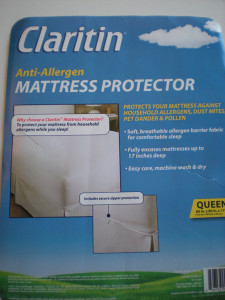When we identify a need in the household, it goes on Dan’s mental list. He doesn’t like to let his list stagnate. He begins to keep an eye out for the item and to research it. Before long, he’s able to give you an outline of the choices available and each choice’s defining features.
Having Dan’s shopping prowess in the family is a huge advantage. It makes the difference between thinking about a potential purchase to improve the house and actually making it. One of Dan’s recent quests resulted in a fabulous new refrigerator.
A while back we purchased some new mattresses and needed mattress covers. Naturally you know who the best man for the job was.
Dan returned from Bed, Bath & Beyond toting Claritin® mattress covers.
What you may not know is that three of the four members of my household suffer from seasonal allergies. Though there wasn’t much difference between the mattress cover options, Dan figured one that fought allergens made sense for us.
Dan was kinder and more forgiving of the Claritin® brand than I was.
To me, Claritin® is the chemical panacea to make spring and summer more enjoyable for me, my son and my daughter. I trust it to solve allergy problems chemically.
But mattress protectors? Really? When did cloth enter their purview?
I didn’t see any difference or benefit to the mattress covers coming from the Claritin® brand. It wasn’t credible to me. But I could envision how it happened.
Claritin® lost its patent in December 2002, opening the door to generics which cost much less and cannibalized Claritin® sales. At its peak, prescription Claritin® was pulling in over $3 billion per year. By 2005 sales had plummeted to $1 billion per year. Last year sales totaled $471 million.
In an effort to find new revenue, some Claritin® brand manager theorized that the brand could be applied to any allergy-fighting product. In September 2010 Merck licensed the use of the Claritin® brand to London Luxury for a line of anti-allergen bedding.
Claritin® was dealing with a classic Brand in Adolescence problem. It had been in the U.S. ten years when its patent expired. It needed to find a new way to grow.
New offerings can help a brand in adolescence grow or transition, but they need to make sense. To make sense, they need to address the problem the brand solves and the role it plays in the customer’s mind.
Clearly there are enough people who find the Claritin® brand credible for anti-allergen mattress protectors. They are still on the market.
But many brands haven’t been so lucky, suffering expensive and sometimes embarrassing mishaps.
- Life Savers® Soda – People anticipated it to be as sweet as the candy and weren’t interested.
- Cosmopolitan® Yogurt – Yes, the magazine. Need I say more?
- Clairol® “Touch of Yogurt” Shampoo – With yogurt as the most prominent word on the package, some women tried to eat this product instead of use it to shampoo their hair. They got sick and sued the company. Voilà, end of the product.
- Bic® Women’s Disposable Underwear – Disposable pens? Yes. Disposable razors. Absolutely. Disposable underwear? Um, no thanks.
So how do you know how far you can extend your brand, and which new product ideas are likely to fly?
- Get clear on the problem your brand solves. Your brand isn’t your product. It is a solution that makes your customers’ lives easier in some way and that they have come to rely upon. Figure out what that is.
- Talk to your customers to understand all aspects of this problem.
- Brainstorm new ideas to fill gaps in the solutions that you offer. Circle back to run these new product ideas by the litmus test – are they germane to the problem your brand solves?
- Test new ideas before launching. Have some valued customers provide feedback to get insight as to whether you can credibly market the new offering ideas.
It’s easy to laugh at other brands’ snafus, but it’s harder when it’s your own dime.
As for me, I sleep just fine on my Claritin® mattress cover and am grateful to have such an awesome shopper in the house!
If you liked this post, you’ll love the next one.
To have future posts sent to your inbox...


Great article and a good reminder that your Brand isn’t your product. By the way, after reading about the Claritin mattress cover, it made me curious and I looked up other uses of the Brand. Not surprisingly, a Claritin Air purifier is also being marketed and appears to be doing quite well. They have positioned the product as coming from the #1 recommended non-drowsy OTC allergy brand–which seems like a reasonably effective use/extension of the Claritin brand name.
Glad you liked the article, Cris. Thanks for sharing your research on the Claritin Air Purifier. Clearly the Claritin brand has a strong allergy clearing reputation. It is curious though that a brand that touts its non-drowsy benefit still sells mattress covers!